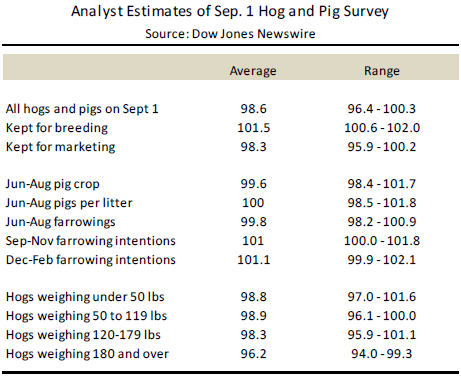



CME: Hogs & Pigs Report Highly Anticipated
US - USDA will release on Friday, 27 September, its latest estimates of the US Hogs and Pigs inventory as of 1 September. The report is usually highly anticipated by market participants as it provides key data for estimating pipeline hog supplies. It also gives an indication as to what producers intend to do in the next few quarters, write Steve Meyer and Len Steiner.This time, there is heightened anticipation given the shortfall in hog supplies in recent weeks and ongoing speculation as to the impact of PEDv disease this past summer. As you can see from the table below, analysts have widely different opinions as to the number of hogs on the ground.

On average, the seven analysts polled by Dow Jones indicated that they expect the total inventory as of September 1 to be down 1.4 per cent compared to a year ago. However, the range of expectations varied from –3.6 per cent to +0.3 per cent.
The total inventory number is a composite of hogs that will come to market in the next 4+ months as well as the inventory of the breeding herd. With regard to the breeding herd, analysts broadly agree that the 1 September inventory will be larger than a year ago.
The average of estimates pegs the breeding herd at +1.5 per cent from a year ago. This would put the breeding herd as of 1 September at 5.875 million head, compared to 5.882 million head on 1 June and 5.788 million head on 1 September 2012.
The expected increase in the breeding herd reflects lower rates of sow slaughter between 1 June and 31 August as well as increased gilt retention as improved forward margins provide an incentive to expand the herd.
According to data from University of Missouri, gilt slaughter has been running below year ago levels for much of the summer. Monthly sow slaughter also shows that for the period Jun—Aug, total US sow slaughter /was 708,000 head, down 60,700 head or 7.9 per cent from a year ago.
Imports of breeding females from Canada during this period also have increased considerably, up about 8,653 head (+56 per cent) from a year ago. PEDv disease also may have contributed to an increase in the breeding herd. Producers have been very cautious in how they market sows this summer for fear of bringing the disease into their farms.
The number of market hogs on the ground is the big unknown at this point. Hog slaughter in the first three weeks of September has been 6.322 million head, down 574,000 head or 8.3 per cent from the same period a year ago. While we are comparing to some unusually large slaughter weeks last year, there is serious concern that the number of hogs on the ground may be very different that what the June 1 survey indicated.
Indeed, there is broad expectation that USDA will go back and revise some of its pig crop numbers from June given current slaughter trends. Analysts expect the inventory of hogs over 180 pounds to be down 3.8 per cent from a year ago but the range is between down 6 per cent and down 0.7 per cent (which is an odd range since we already know part of the answer).
The chart below shows a moving 7-day total of daily hog slaughter. Immediately below we have included roughly the marketing windows for the various weight categories. This is not exact of course as we had to make some assumptions on average daily gains. But it gives you an indication when the various categories are expected to come to market.

As for expansion, the expectation is for Dec - Feb farrowings to be up 1.1 per cent on average with some expecting farrowings above 2 per cent. Add to this a 1—1.5 per cent pig per litter gain and we could easily have a pig crop of +2 to +3 per cent for early next year.








